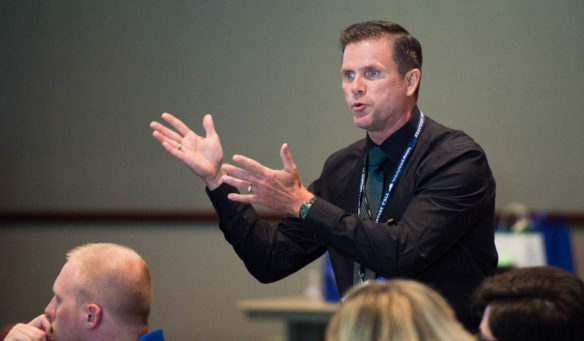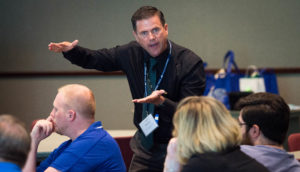
Doug Henry, a social studies teacher at Bullitt Lick Middle School (Bullitt County) leads a session about using thought experiments as an instructional technique at the Kentucky History Education Conference at the Thomas D. Clark Center for Kentucky History.
Photo by Bobby Ellis, June 23, 2016
By Brenna R. Kelly
Brenna.kelly@education.ky.gov
Call it choose your own adventure history.
“Anything you do with gaming, students love it,” said Doug Henry, social studies teacher at Bullitt Lick Middle School.
Henry turned one of his 8th grade U.S. History units into a game –a game that involves a close reading of primary and secondary sources, making inferences, using perspective and communicating an outcome.
“Students get excited about it because they realize they are drivers of history,” he said. “They are in a position where they are shaping something and all of us want to be creators.”
Henry’s game allows students to explore what could have happened if historical figures had made slightly different decisions in times of crisis.
Say, for instance, that the Continental Congress had decided to relieve Gen. George Washington of his command after his loss at Brandywine. His replacement, Gen. Horatio Gates, wasn’t quite as good a commander and lost the entire American army in battle. But Gates’ counterpart, Benedict Arnold, was able to win the Battle of Saratoga and therefore secured the colonies of New York, Massachusetts, Connecticut, Rhode Island and Vermont.
“All the other colonies revert to British control as a result of Gates’ loss,” Henry said. “So a small little piece of the colonies become the new United States and Benedict Arnold becomes the first president of the United States.
“It’s fascinating stuff,” he said, “and it could have happened that way if things had been slightly different.” (See the full example of the lesson in the gallery below.)
The idea came from the online game Mission US, which allows students to become an ordinary person during a significant period in history and make choices based on historical events. The scenarios include the American Revolution, the Underground Railroad, and Native American life and immigrant life at the turn of the century.
“It’s really good because it places the student in the role of making decisions. They can come up with alternate history in those games as well, but they are kind of limited,” Henry said. “I thought it would be really neat if students could take this and apply it so that they could develop their own alternate ending.”
Henry recently explained the game and how it teaches students to draw inferences and understand perspective during a session at the Kentucky History Education Conference at the Thomas D. Clark Center for Kentucky History.
For the past two years, Henry has used the game to study the Indian Removal Act of 1830. Students begin by reading primary and secondary documents, then they make a chart that includes the names, titles, job responsibilities, goals, motivations and actions of all the characters involved.
Once the students know the characters, they read two primary documents, such as a speech by President Andrew Jackson and a speech from a Native American leader. Students pick one of the characters and then have a conversation with another student using that person’s perspective. They must have conversations as five different people.
Then the fun begins. Students develop scenarios in which characters must choose one of two options. The choices the students make change the outcome of history.
“They aren’t just making stuff up,” he said. “They aren’t going to create little men from Mars, but have specific people in history they are working with. From the ground work and the understanding they have, they can now leap from that and create an alternate history that makes sense.”
Students have to understand each character’s motivations and why he or she might have chosen a different action than what actually occurred.
“Just one person’s decision could have led to a completely different outcome to our nation’s history,” Henry said. “And students come up some brilliant stuff just by using real history to create counterfactuals.”

Doug Henry, a social studies teacher at Bullitt Lick Middle School (Bullitt County) leads a session about using thought experiments as an instructional technique at the Kentucky History Education Conference at the Thomas D. Clark Center for Kentucky History.
Photo by Bobby Ellis, June 23, 2016
The students write their counterfactuals, alternate endings events that have already occurred, using Google Docs so Henry can monitor the writing in real time and give feedback. Students start with background, then set the scene with their characters and lay out the choices. Each counterfactual has three set of choices that ultimately lead to the altered history.
The game applies to both the current Kentucky social studies standards and the proposed new standards, Henry said. Under the current standards, students must be able to think in a historical context, analyze the perspectives of individuals and explain how history is shaped by cause-and-effect relationships.
In the proposed standards, students have to organize evidence from historical sources and evaluate the relevancy and usefulness of different historical sources.
Before developing the game, Henry said his students struggled with making inferences based on primary sources and predicting cause-and-effect relationships. On post-assessments they could only get the inference or outcomes correct 47 percent of the time, he said.
After using the game, that had increased to 67 percent, he said.
“Am I there yet? No,” he said. “I want to get to 80 percent because making inferences is the most difficult thing for students to make based off documents.”
The game is a good way for students to connect with history, which can feel distant and irrelevant to students, said Jennifer Fraker, Kentucky Department of Education social studies consultant.
“Allowing space for students to make meaning of content and connect it to their understanding of the world around them is essential and supports good teaching and learning in social studies,” Fraker said.
The game also teaches students the skills they need to think historically, and learning those processes will allow them to apply those skills to all kinds of situations, she said.
Though Henry uses the Indian Removal Act, the game would work with any period of history that contains controversy, he said. Henry recommended using the technique with the Revolutionary War, the Civil War or the Underground Railroad.
“Whatever period of history you are teaching, there’s always moments of controversy,” he said. “You can choose whatever characters you want, whatever primary documents you want and you can make this fit and you can make this successful.”
John Whipple, an 8th-grade social studies teacher at Breckinridge County Middle School, said he would like to use the game during his Civil War unit.
“I can already see the storylines they could create. What if Abraham Lincoln wasn’t killed, or what if the south had won?” he said. “Students always ask those kinds of questions anyway. This would give them the chance to explore that.”
Henry also has his students give presentations of their counterfactuals and invites parents, other teachers or community members to attend.
“Whenever students have a public audience, they seem to up their game,” he said.
Henry grades the students’ work with a rubric that takes into account vocabulary, use of characters, writing in complete sentences and citations. The unit takes about a month, but Henry intersperses other lessons during that time.
Eighth-grade social studies teacher Evie Wilkinson said she’d like a try the lesson with her students at Shelby County High School, but worried that she would not be able to devote an entire month to the game.
“I really like that students would be able to choose their own ending to history based on real traits of the historical characters,” she said. “I think they’d have fun with it and if they get to make the decision themselves, then they will remember it. They will remember the circumstances. They will remember the characters.”
MORE INFO …
Doug Henry Doug.Henry@bullitt.kyschools.us












Leave A Comment